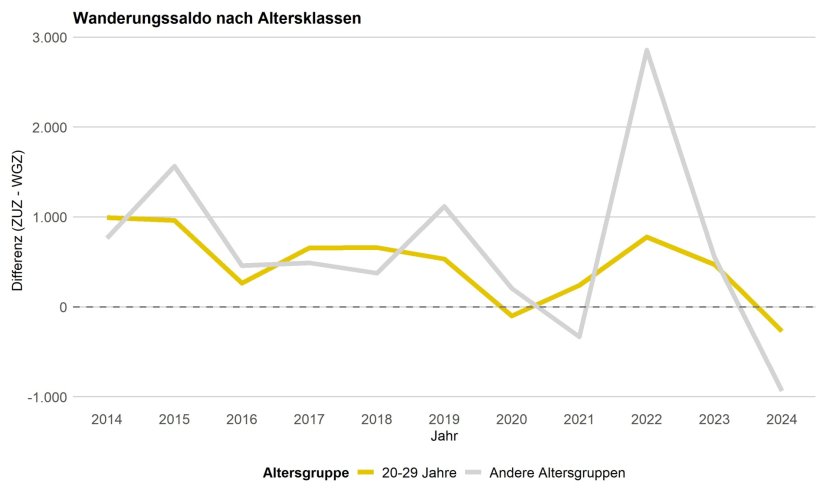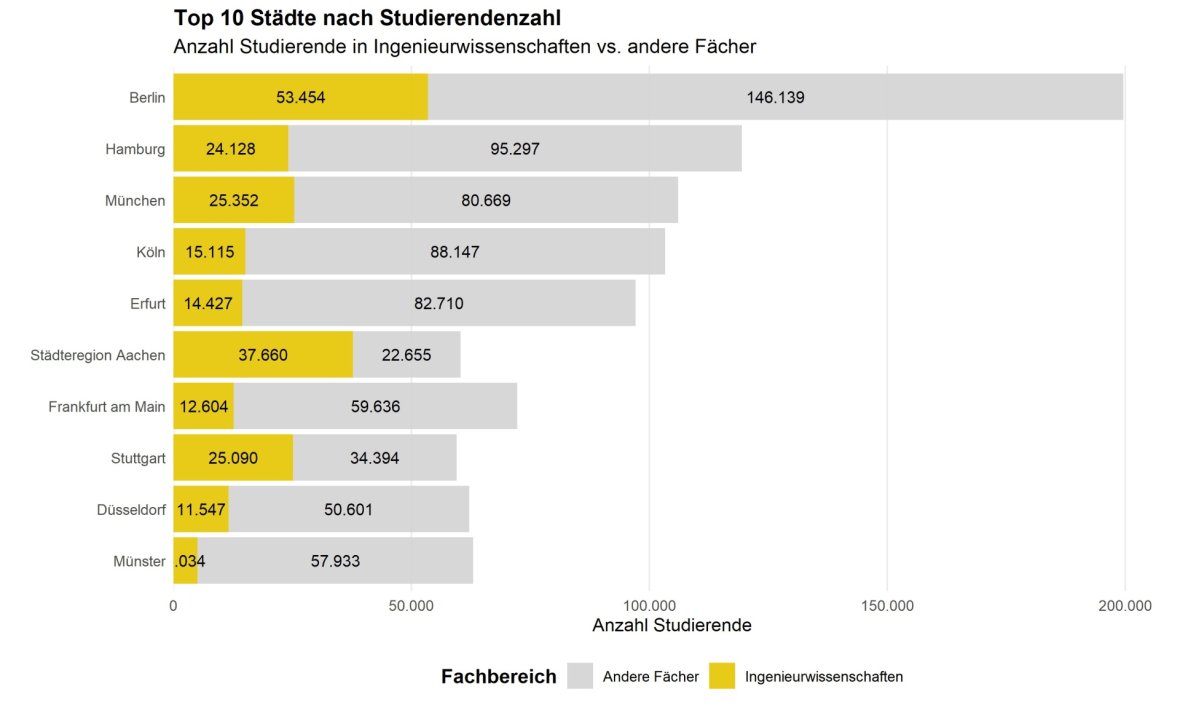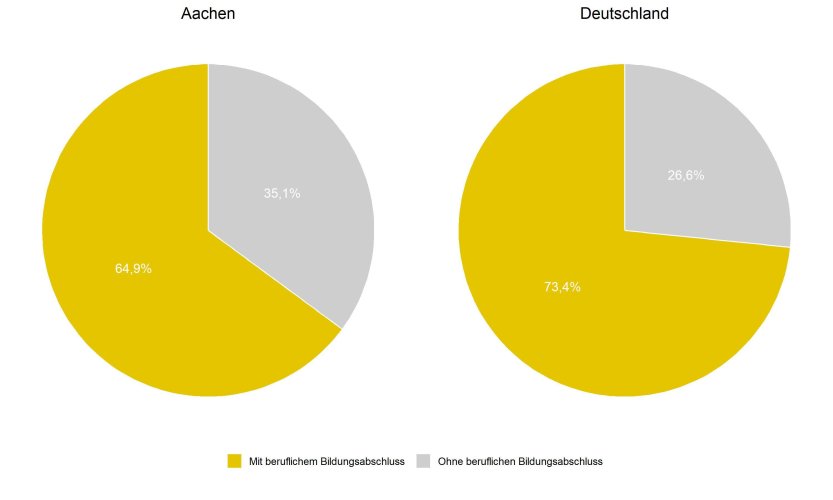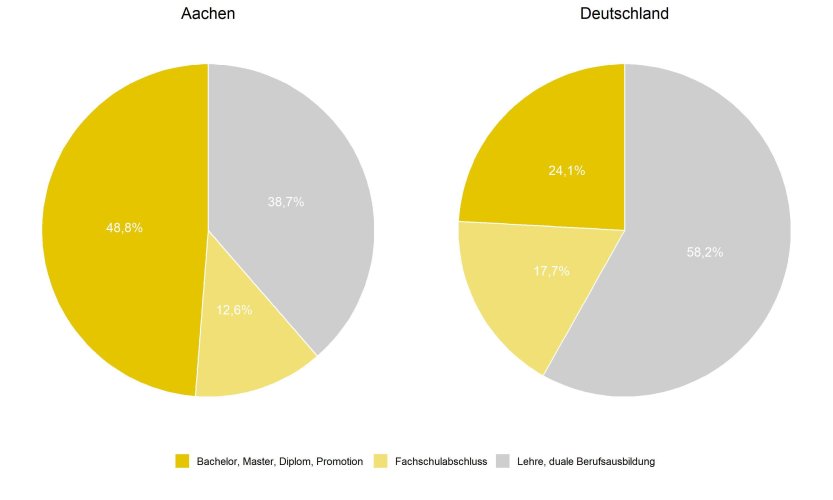Aachen in figures 2025
October 2025: Aachen as a student city
Just in time for the start of the winter semester 2025, this edition of Aachen in Figures looks at the numbers of students. The city of Aachen is strongly influenced by its student population. This is also reflected in the population statistics. The latest official figures from the Federal Statistical Office from the winter semester 2022 put the total number of students in the Aachen city region (including Jülich) at 60,315. A significant proportion of these students live in the city area. According to the 2022 census figures, the proportion of people aged between 20 and 29 in the total population of the city of Aachen was 23%. In this category, Aachen is the leader among the independent cities in NRW. This issue explains how far-reaching the influence of students is on various (population) statistics.
Population
Aachen is not only generally known as a student city, but also for the unequal gender ratio of students due to the still male-dominated technical subjects. This ratio is also reflected in the population statistics. In the results of the 2022 nationwide census, only the cities of Giessen, Marburg, Tübingen and Heidelberg had a larger proportion of people aged between 20 and 29. In terms of the proportion of men in this age group in the total population, Aachen is the nationwide leader. 13.8 percent of the population are men between the ages of 20 and 29. This corresponds to a total number of 36,095. Only Neubiberg, the location of the Bundeswehr University in Munich, has a similarly high proportion at 13.7 percent. Here, however, the total number of men in this age group is only 1,970.
 City of Aachen / Department of Citizens' Dialogue and Administrative Management, Statistics and Elections Division
City of Aachen / Department of Citizens' Dialogue and Administrative Management, Statistics and Elections DivisionSource: Census 2022
Migration movements
Students also have a clearly measurable influence on people moving into and out of Aachen. In the years 2014 to 2024, the average number of people aged between 20 and 29 moving in was 9,990 and the average number of people moving out was 9,518. Although this age group only makes up 23% of the total population according to the census, the rest of the population of the city of Aachen hardly shows any higher figures. An average of 10,710 inflows and 10,063 outflows were registered here. The migration balance (inflows - outflows) shows a similar picture. The average here is 472 in the 20 to 29 age group and 647 for all other age groups. The annual figures are shown in the graph below. This shows that net migration has fallen for both groups since 2014. In 2020 and 2024, net migration was negative, otherwise it was always positive.
 City of Aachen / Department of Citizens' Dialogue and Administrative Management, Statistics and Elections Division
City of Aachen / Department of Citizens' Dialogue and Administrative Management, Statistics and Elections DivisionSource: City of Aachen register
Students in Aachen
Nationwide student numbers are available in the regional database of the Federal Statistical Office (Destatis). The most recent figures are from the winter semester 2022. For Aachen, the figures for the Aachen city region including students at the Jülich research location are available. Since 2015, the total number of students in Aachen has risen from 54,589 to 60,315. Engineering students make up the largest proportion. In the period under review, this proportion averaged 63.23 percent. Law, economics and social sciences have the second-largest share with an average of 13.29%.
 City of Aachen / Department of Citizens' Dialogue and Administrative Management, Statistics and Elections Division
City of Aachen / Department of Citizens' Dialogue and Administrative Management, Statistics and Elections DivisionSource: Destatis
Aachen student numbers in a national comparison
According to Destatis, the total number of students in the Aachen city region, including the Jülich research location, was 60,315 in the winter semester of 2022, putting the region in 9th place in a national comparison. Looking at engineering sciences alone, only Berlin has a higher number of students. This clearly shows how important engineering students are for Aachen as a study location.
 City of Aachen / Department of Citizens' Dialogue and Administrative Management, Statistics and Elections Division
City of Aachen / Department of Citizens' Dialogue and Administrative Management, Statistics and Elections DivisionSource: Destatis
Overall, it can be said that Aachen stands out even in the group of student cities. Aachen is among the leaders in both population statistics and student statistics, although many of the cities compared here have significantly more inhabitants.
February 2025: Census - Aachen in structural comparison
Since July 2024, the results of the 2022 census have gradually been published in the Federal Statistical Office's census database. As the survey took place throughout Germany, the data can be used to draw interesting structural comparisons between German municipalities. This edition of "Aachen in Figures" takes a closer look at some aspects in which Aachen stands out from the crowd of German municipalities. All of the data considered comes from the census database and relates to the cut-off date of the survey (February 15, 2022).
Demography
Aachen is a student city with significantly more male than female students. This is clearly reflected in the city's demographics. In fact, men between the ages of 20 and 29 made up 13.8 percent of Aachen's population in the census data. This is the highest figure in a German comparison of all municipalities with more than 10,000 inhabitants and also stands out among university cities. For women in this age group, Aachen ranked 15th in the national comparison with 9.2 percent. The chart below shows the percentage shares of the various age groups in the total population of the municipalities under consideration. The light yellow lines represent the national average. The Aachen values are represented by the dark yellow line.
 City of Aachen / Department of Citizens' Dialogue and Administrative Management, Statistics and Elections Division
City of Aachen / Department of Citizens' Dialogue and Administrative Management, Statistics and Elections DivisionEducation
As part of the 2022 census, around 10 percent of the population were asked to provide more detailed information about their living conditions. The highest level of education was one of the characteristics surveyed. The results of the survey were extrapolated to the total population by the Federal Statistical Office. In the data under consideration, the figures for all persons over the age of 15 were taken into account. The influence of students can also be seen here: 35.1 percent of Aachen residents do not (yet) have a vocational qualification. The German average is 26.6 percent. This means that Aachen is also well above the average for German municipalities with more than 10,000 inhabitants.
 City of Aachen / Department of Citizens' Dialogue and Administrative Management, Statistics and Elections Division
City of Aachen / Department of Citizens' Dialogue and Administrative Management, Statistics and Elections DivisionLooking at the distribution of educational qualifications, Aachen also stands out in a German comparison. The proportion of people with an academic degree (Bachelor's, Master's, Diplom, Magister or PhD) in Aachen is twice as high as the German average, at 48.8% of vocational qualifications. The proportion of graduates who have completed an apprenticeship or vocational training in the dual system is significantly lower than the national average. Tübingen has the highest proportion of graduates at 63.8%.
 City of Aachen / Department of Citizens' Dialogue and Administrative Management, Statistics and Elections Division
City of Aachen / Department of Citizens' Dialogue and Administrative Management, Statistics and Elections DivisionLiving situation and households
The high proportion of students in Aachen is also reflected in the relationship status of residents: at 53.4 percent, more than half of Aachen residents were single as of May 15, 2022. Aachen ranks sixth in the national comparison. Only Tübingen, Marburg, Heidelberg, Freiburg and Giessen had a higher proportion of single residents. 32.5 percent of residents were married or in a registered civil partnership. This figure is ten percentage points below the national average of 42.5 percent. The groups in the corresponding chart with a reference to "marriage" also include the equivalent from registered partnerships. For example, the category "Divorced" also includes people whose registered civil partnership has been dissolved.
 City of Aachen / Department of Citizens' Dialogue and Administrative Management, Statistics and Elections Division
City of Aachen / Department of Citizens' Dialogue and Administrative Management, Statistics and Elections DivisionThe types of household considered in the 2022 census paint a similar picture: The chart below shows the percentage distributions of the different household types in Aachen and the German average. Households with marriages, registered partnerships and non-marital partnerships were grouped together in the "Partnership" category. The first thing that stands out here is the high proportion of single-person households. Here, Aachen is well above the national average. The highest value in the German comparison was found in Regensburg. However, at 58.6 percent, this is only around five percentage points above the Aachen figure. Aachen has the fifth highest proportion of shared flats - namely 6.2 percent. Only Tübingen with 7.0 percent, Heidelberg with 6.6 percent, Marburg with 6.4 percent and Giessen with 6.3 percent achieve higher values here.
 City of Aachen / Department of Citizens' Dialogue and Administrative Management, Statistics and Elections Division
City of Aachen / Department of Citizens' Dialogue and Administrative Management, Statistics and Elections Division